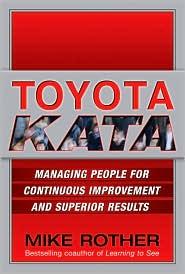While other authors have written about Toyota’s manufacturing principles and the company’s approach to efficiency, Mike Rother is the first to devote six years of study to Toyota’s actual management behavior—revealing the essential kata—in his book, Toyota Kata: Managing People for Improvement, Adaptiveness, and Superior Results (McGraw-Hill, 2010).
 |
Toyota instills an invaluable mindset in its employees at all levels. When thinking and behavior patterns are repeated over and over in daily work, they become a way of doing something, a method, or routine. In Japan such patterns and routines are called kata. Organized around Toyota’s primary approaches to thinking and acting, Toyota Kata delivers proven patterns—and how to develop them—that can help any manager accelerate a team.
Rother explains how to improve management’s approach through the use of two kata:
…
Add new comment